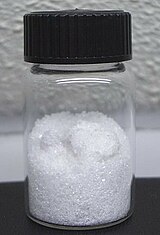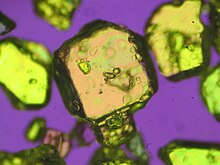 | |

| |
 | |
| Names | |
|---|---|
| IUPAC name
Silver nitrate
| |
| Systematic IUPAC name
Silver(I) nitrate | |
| Other names
Nitric acid silver(1+) salt
Lapis infernalis Argentous nitrate | |
| Identifiers | |
3D model (JSmol)
|
|
| ChEBI | |
| ChEMBL | |
| ChemSpider | |
| ECHA InfoCard | 100.028.958 |
| EC Number |
|
PubChem CID
|
|
| RTECS number |
|
| UNII | |
| UN number | 1493 |
CompTox Dashboard (EPA)
|
|
| |
| |
| Properties | |
| AgNO3 | |
| Molar mass | 169.872 g·mol−1 |
| Appearance | colorless solid |
| Odor | Odorless |
| Density | 4.35 g/cm3 (24 °C) 3.97 g/cm3 (210 °C)[1] |
| Melting point | 209.7 °C (409.5 °F; 482.8 K)[1][3] |
| Boiling point | 440 °C (824 °F; 713 K) decomposes[1] |
| 122 g/100 mL (0 °C) 170 g/100 mL (10 °C) 256 g/100 mL (25 °C) 373 g/100 mL (40 °C) 912 g/100 mL (100 °C)[2] | |
| Solubility | Soluble in acetone,[1] ammonia, ether, glycerol |
| Solubility in acetic acid | 0.776 g/kg (30 °C) 1.244 g/kg (40 °C) 5.503 g/kg (93 °C)[3] |
| Solubility in acetone | 0.35 g/100 g (14 °C) 0.44 g/100 g (18 °C)[2] |
| Solubility in benzene | 0.22 g/kg (35 °C) 0.44 g/kg (40.5 °C)[2] |
| Solubility in ethanol | 3.1 g/100 g (19 °C)[2] |
| Solubility in ethyl acetate | 2.7 g/100 g (20 °C)[3] |
| log P | 0.19 |
| −45.7·10−6 cm3/mol | |
Refractive index (nD)
|
1.744 |
| Viscosity | 3.77 cP (244 °C) 3.04 cP (275 °C)[3] |
| Structure | |
| Orthorhombic, oP56[4] | |
| P212121, No. 19[4] | |
| 222[4] | |
a = 6.992(2) Å, b = 7.335(2) Å, c = 10.125(2) Å[4] α = 90°, β = 90°, γ = 90°
| |
| Thermochemistry | |
Heat capacity (C)
|
93.1 J/mol·K[1] |
Std molar
entropy (S⦵298) |
140.9 J/mol·K[1] |
Std enthalpy of
formation (ΔfH⦵298) |
−124.4 kJ/mol[1] |
Gibbs free energy (ΔfG⦵)
|
−33.4 kJ/mol[1] |
| Pharmacology | |
| D08AL01 (WHO) | |
| Hazards | |
| Occupational safety and health (OHS/OSH): | |
Main hazards
|
Reacts explosively with ethanol. Toxic. Corrosive. |
| GHS labelling: | |
    [5] [5]
| |
| Danger | |
| H272, H314, H410[5] | |
| P220, P273, P280, P305+P351+P338, P310, P501[5] | |
| NFPA 704 (fire diamond) | |
| Lethal dose or concentration (LD, LC): | |
LDLo (lowest published)
|
800 mg/kg (rabbit, oral) 20 mg/kg (dog, oral)[6] |
Except where otherwise noted, data are given for materials in their standard state (at 25 °C [77 °F], 100 kPa).
| |

Silver nitrate is an inorganic compound with chemical formula AgNO
3. It is a versatile precursor to many other silver compounds, such as those used in photography. It is far less sensitive to light than the halides.[citation needed] It was once called lunar caustic because silver was called luna by ancient alchemists who associated silver with the moon.[7] In solid silver nitrate, the silver ions are three-coordinated in a trigonal planar arrangement.[4]
- ^ a b c d e f g h Lide, David R., ed. (2009). CRC Handbook of Chemistry and Physics (90th ed.). Boca Raton, Florida: CRC Press. ISBN 978-1-4200-9084-0.
- ^ a b c d Seidell, Atherton; Linke, William F. (1919). Solubilities of Inorganic and Organic Compounds (2nd ed.). New York City: D. Van Nostrand Company. pp. 617–619.
- ^ a b c d Kiper, Ruslan Anatolievich. "silver nitrate". Chemister.ru. Retrieved 2014-07-20.
- ^ a b c d e Meyer, P.; Rimsky, A.; Chevalier, R. (1978). "Structure du nitrate d'argent à pression et température ordinaires. Exemple de cristal parfait". Acta Crystallogr. B. 34 (5): 1457–1462. Bibcode:1978AcCrB..34.1457M. doi:10.1107/S0567740878005907.
- ^ a b c Sigma-Aldrich Co., Silver nitrate. Retrieved on 2014-07-20.
- ^ "Silver (metal dust and soluble compounds, as Ag)". Immediately Dangerous to Life or Health Concentrations (IDLH). National Institute for Occupational Safety and Health (NIOSH).
- ^ "Definition of Lunar Caustic". dictionary.die.net. Archived from the original on 2012-01-31.
